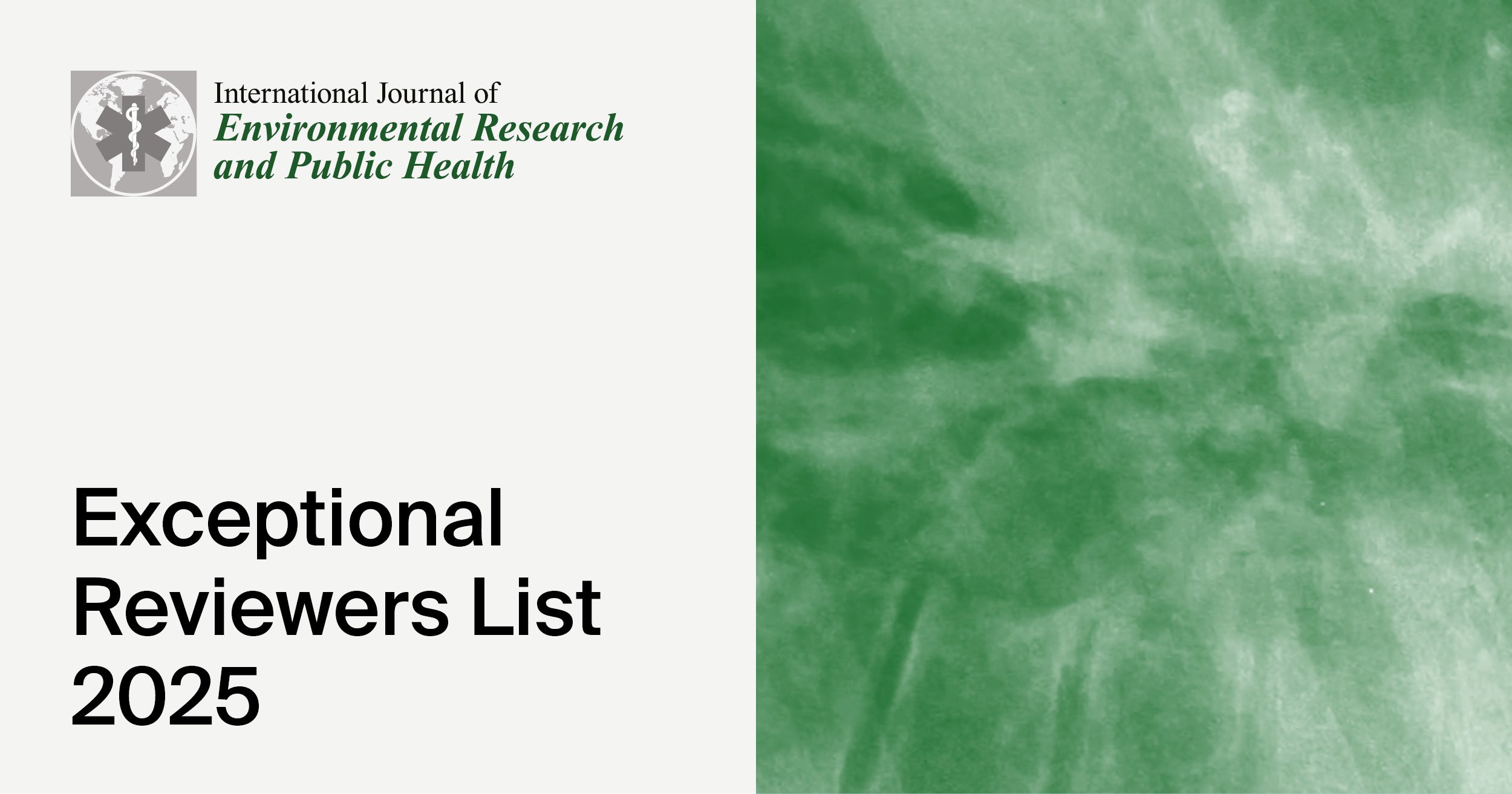Journal Description
International Journal of Environmental Research and Public Health
International Journal of Environmental Research and Public Health
is a transdisciplinary, peer-reviewed, open access journal published monthly online by MDPI. It covers Global Health, Healthcare Sciences, Behavioral and Mental Health, Infectious Diseases, Chronic Diseases and Disease Prevention, Exercise and Health Related Quality of Life, Environmental Health and Environmental Sciences. The International Society Doctors for the Environment (ISDE) and Italian Society of Environmental Medicine (SIMA) are affiliated with IJERPH and their members receive a discount on the article processing charges.
- Open Access— free for readers, with article processing charges (APC) paid by authors or their institutions.
- High Visibility: indexed within Scopus, PubMed, MEDLINE, PMC, Embase, GEOBASE, CAPlus / SciFinder, and other databases.
- Journal Rank: CiteScore - Q1 (Public Health, Environmental and Occupational Health)
- Rapid Publication: manuscripts are peer-reviewed and a first decision is provided to authors approximately 25.8 days after submission; acceptance to publication is undertaken in 3.3 days (median values for papers published in this journal in the second half of 2024).
- Recognition of Reviewers: reviewers who provide timely, thorough peer-review reports receive vouchers entitling them to a discount on the APC of their next publication in any MDPI journal, in appreciation of the work done.
- Testimonials: See what our editors and authors say about IJERPH.
- Sections: published in 7 topical sections.
- Companion journal: Air.
Latest Articles
My Pillow Is Filled with Tears… Syrian Refugees’ Journey to Australia: Narratives of Human Courage and Resilience
Int. J. Environ. Res. Public Health 2025, 22(5), 691; https://doi.org/10.3390/ijerph22050691 (registering DOI) - 27 Apr 2025
Abstract
This article showcases Syrian refugees’ narratives of trauma and survival, through a phenomenological approach to in-depth research, with refugees who have resettled in Australia. It explores their journey towards resettlement, highlighting the nexus between displacement in the home–transit–host countries and the biopsychosocial determinants
[...] Read more.
This article showcases Syrian refugees’ narratives of trauma and survival, through a phenomenological approach to in-depth research, with refugees who have resettled in Australia. It explores their journey towards resettlement, highlighting the nexus between displacement in the home–transit–host countries and the biopsychosocial determinants of mental health. Since the 2011 uprising, over 12 million Syrians have been displaced, both internally and worldwide. A refugee’s journey to safety often involves multiple displacements and exposure to dangerous, life-threatening, and dehumanising experiences. We have therefore adopted a qualitative approach that counters this dehumanisation by honouring the unique humanity in the voice of each of our research participants. This article aims to portray the nuanced interdependence between the individual, social, and political contexts of seven Syrian refugees’ lived experiences through an in-depth consideration of what they have told us, how they narrate their stories, and the meanings they ascribe to what they have experienced. The findings of this small yet eloquent study reinforce the insight that the journey to resettlement is far from linear and that resettlement itself is a process marked by recurrent and persistent complexities. The article suggests that the resilience of these refugees is best understood as an ethical and altruistic commitment to collective well-being, transcending notions of individual fortitude.
Full article
(This article belongs to the Special Issue Refugee Health and Well-Being: Psychological, Behavioral and Biochemical Insights)
Open AccessSystematic Review
Green Environments for Sustainable Brains: Parameters Shaping Adaptive Neuroplasticity and Lifespan Neurosustainability—A Systematic Review and Future Directions
by
Mohamed Hesham Khalil
Int. J. Environ. Res. Public Health 2025, 22(5), 690; https://doi.org/10.3390/ijerph22050690 (registering DOI) - 26 Apr 2025
Abstract
►▼
Show Figures
As global urbanisation is rising and public health challenges intensify, this systematic review is conducted at a critical time to explore and explain the associations between the parameters of green environments and nuanced adaptive neuroplasticity in the human brain to advance the development
[...] Read more.
As global urbanisation is rising and public health challenges intensify, this systematic review is conducted at a critical time to explore and explain the associations between the parameters of green environments and nuanced adaptive neuroplasticity in the human brain to advance the development of health-focused sustainable cities and buildings in line with the concept of neurosustainability. This review includes studies involving participants of all ages and genders, with no restrictions on health conditions, exposed to green environments regardless of built environment comparisons. A systematic search of Scopus, PubMed, and Web of Science identified relevant studies published up to November 2024. The risk of bias was assessed using the PEDro scale and ROBINS-I domains, and data were analysed narratively due to heterogeneity. Twenty-three studies were included, conducted across the USA, UK, Germany, Spain, Bulgaria, the Netherlands, Japan, and South Korea. Findings reveal that green environments are associated with positive, region-specific brain changes across the lifespan, surprisingly from before birth to late adulthood. While forests showed more significant effects than blue spaces or urban green spaces, residential greenness emerged as a consistently effective exposure, especially within a 300–500 m buffer around home addresses, provided that sky visibility is present. Notably, no studies have examined green architecture or biophilic interiors, although they are more proximal, are associated with greater exposure time, have antagonistic effects, and may potentially limit sky visibility, highlighting a key gap for future research. Limitations include heterogeneity in exposure definitions, methodologies, and targeted brain regions. Still, this review offers a novel synthesis, providing insight into how greening the built environment may sustain not only the planet but also the plasticity of the brain. This review is registered with INPLASY (INPLASY2024110103) and forms part of a doctoral research project funded by the Cambridge Trust in partnership with the Jameel Education Foundation.
Full article
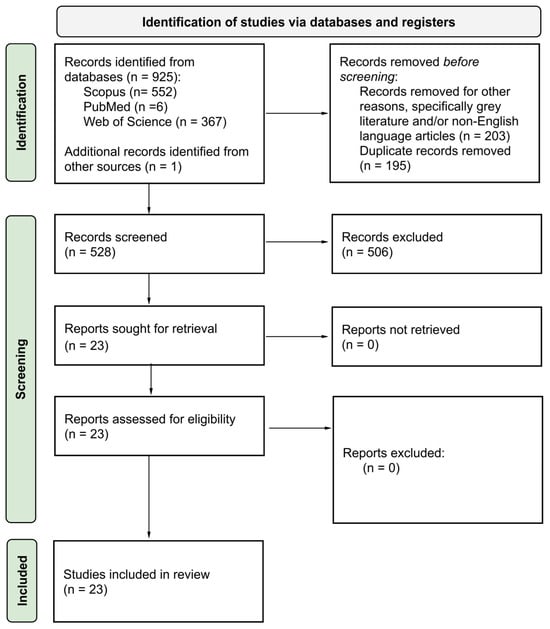
Figure 1
Open AccessArticle
Dietary Fluoride Exposure During Early Childhood and Its Association with Dental Fluorosis in a Sample of Mexican Adolescents
by
Gina A. Castiblanco-Rubio, Emily C. Hector, Jose Urena-Cirett, Alejandra Cantoral, Howard Hu, Karen E. Peterson, Martha M. Tellez-Rojo and E. Angeles Martinez-Mier
Int. J. Environ. Res. Public Health 2025, 22(5), 689; https://doi.org/10.3390/ijerph22050689 (registering DOI) - 26 Apr 2025
Abstract
Dental fluorosis indicates past fluoride intake. People living in Mexico City are exposed to fluoridated salt, which contributes significantly to fluoride intake. This study aimed to (1) estimate fluoride intake during early childhood and fluorosis prevalence in permanent teeth in adolescence and (2)
[...] Read more.
Dental fluorosis indicates past fluoride intake. People living in Mexico City are exposed to fluoridated salt, which contributes significantly to fluoride intake. This study aimed to (1) estimate fluoride intake during early childhood and fluorosis prevalence in permanent teeth in adolescence and (2) identify intake windows associated with higher fluorosis scores in upper central incisors (UCIs). We included 432 participants from the ELEMENT project (Early-Life Exposures in Mexico to Environmental Toxicants), with data on fluoride intake at ages 1–5 and fluorosis (TFI) at adolescence. Median intakes ranged from 0.56 at age 1 to 1.14 mg/day at age 5, exceeding recommendations. All adolescents had some level of fluorosis, predominantly mild (62% with TFI 2). For every 0.1 mg of daily fluoride intake at age 1, the odds of higher TFI in UCIs were 1.08 [95% CI: 1.00–1.17]. At age 2, the odds were marginally significant [OR: 1.07; 95% CI: 1.00–1.16]. In conclusion, for participants of ELEMENT: (1) fluoride intake during early childhood exceeded recommendations and the prevalence of mild fluorosis in adolescence was high, and (2) fluorosis in UCIs was associated with dietary exposure during the first two years of life and may be used in future ELEMENT studies as exposure biomarkers.
Full article
(This article belongs to the Special Issue Influence of Population Exposure to Fluoride on Oral Health)
►▼
Show Figures
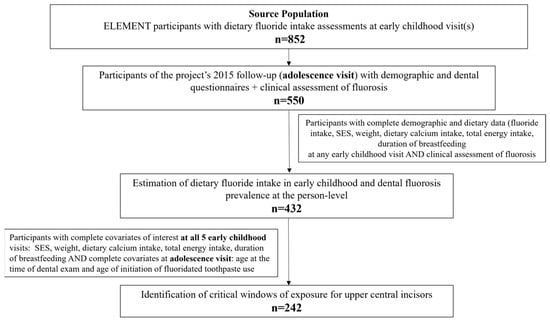
Figure 1
Open AccessArticle
What Guides Organizations’ Current Dementia-Related Practices Across Four Canadian Provinces?
by
Maria Baranowski, Nancy Jokinen, Leslie Udell, Sandy Stemp, Tracey Berman and Shahin Shooshtari
Int. J. Environ. Res. Public Health 2025, 22(5), 688; https://doi.org/10.3390/ijerph22050688 (registering DOI) - 26 Apr 2025
Abstract
: We conducted a survey to learn what guides current dementia-related practice to support community-dwelling adults with intellectual and developmental disabilities who may be experiencing dementia in Canada. We invited organizations working in health, disability, or senior sectors in 4 Canadian provinces to
[...] Read more.
: We conducted a survey to learn what guides current dementia-related practice to support community-dwelling adults with intellectual and developmental disabilities who may be experiencing dementia in Canada. We invited organizations working in health, disability, or senior sectors in 4 Canadian provinces to complete an online cross-sectional survey between April and July 2023. A total of 173 people completed the survey, representing 125 unique organizations, and nearly half resided in Ontario. The most common support and services provided to adults with intellectual and developmental disabilities and their families were related to residential care, day programming, and group home living. Half of our survey respondents reported that they followed dementia-related practice guidelines. The most common guideline followed and early detection tool used were from the National Task Group on Intellectual Disabilities and Dementia Practices and the National Task Group-Early Detection and Screen for Dementia, respectively. Lack of awareness about guidelines and detection tools, challenges to implement the same, and organizational needs for future training and service provision were identified. Commitment to resources to monitor adults with IDD who may be experiencing dementia is recommended to provide meaningful support and service to them and their families.
Full article
(This article belongs to the Special Issue Promoting Mentation: Assessment and Support for Dementia, Depression and Delirium)
Open AccessArticle
Where Muscle Matters: How Regional Differences, Pain, and Gender Define Gamer Health
by
Joanne DiFrancisco-Donoghue, Min-Kyung Jung, Matteo J. Balentine and Hallie Zwibel
Int. J. Environ. Res. Public Health 2025, 22(5), 687; https://doi.org/10.3390/ijerph22050687 (registering DOI) - 26 Apr 2025
Abstract
Competitive gaming presents unique musculoskeletal challenges due to prolonged sitting and repetitive hand and arm movements. This study explores gender-specific regional lean body mass (LBM) differences and their associations with musculoskeletal discomfort in competitive gamers. Sixty participants (30 gamers and 30 matched controls;
[...] Read more.
Competitive gaming presents unique musculoskeletal challenges due to prolonged sitting and repetitive hand and arm movements. This study explores gender-specific regional lean body mass (LBM) differences and their associations with musculoskeletal discomfort in competitive gamers. Sixty participants (30 gamers and 30 matched controls; 15 males and 15 females in each group) underwent DXA scans to assess total and regional LBM, handgrip strength tests, and self-reported musculoskeletal pain surveys. Controls were matched for age and BMI and reported comparable academic and screen time but were not engaged in competitive gaming. Male gamers exhibited significantly reduced forearm (p < 0.05) and upper body LBM (p < 0.001), alongside lower grip strength (p < 0.001), compared to controls. Female gamers demonstrated lower upper body LBM (p = 0.01) but showed no significant differences in forearm lean mass or grip strength. In male gamers, negative correlations were observed between forearm LBM and lower back pain (r = −0.59, p < 0.01), highlighting the protective role of regional LBM against discomfort. Extended gaming duration was associated with increased musculoskeletal pain in both sexes (p < 0.05). These findings emphasize the need for targeted ergonomic interventions and physical conditioning programs to address muscle imbalances and reduce injury risk in esports athletes. Future research should focus on longitudinal and interventional designs to optimize musculoskeletal health and performance in this growing population.
Full article
(This article belongs to the Special Issue Physical Fitness and Injury Prevention in Athletes)
►▼
Show Figures
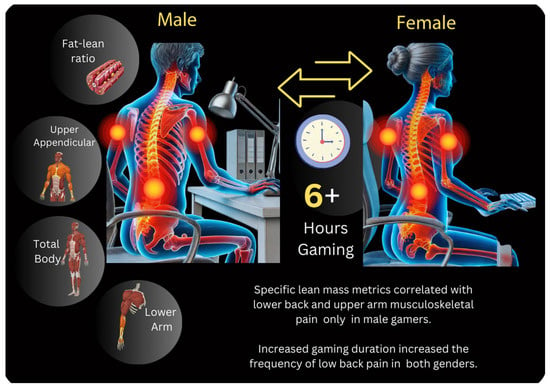
Figure 1
Open AccessArticle
Exploring How Rheumatic Fever Is Portrayed on TikTok: A Descriptive Content Analysis
by
Siobhan Tu’akoi, Malakai Ofanoa, Samuela Ofanoa, Maryann Heather, Hinamaha Lutui and Felicity Goodyear-Smith
Int. J. Environ. Res. Public Health 2025, 22(5), 686; https://doi.org/10.3390/ijerph22050686 (registering DOI) - 26 Apr 2025
Abstract
TikTok is a popular social media platform offering educational opportunities for health issues such as rheumatic fever, which primarily affects 4–19-year-olds globally. This content analysis aimed to explore the type of rheumatic fever content available and popular on TikTok and the role that
[...] Read more.
TikTok is a popular social media platform offering educational opportunities for health issues such as rheumatic fever, which primarily affects 4–19-year-olds globally. This content analysis aimed to explore the type of rheumatic fever content available and popular on TikTok and the role that rheumatic fever representation may play in shaping public understanding and attitudes. The top 100 TikTok video posts under the hashtag #rheumaticfever were examined. Descriptive statistics were used to summarize video metrics and deductive thematic analysis enabled the coding of video content. The majority of TikTok users creating rheumatic fever content were patients or family members of people suffering from rheumatic fever (42%), followed by health professionals (30%). Forty-three percent of videos had negative connotations and personal stories were the most commonly coded type of video (42%). In terms of rheumatic fever content, symptoms (n = 59), medications/treatment (n = 37) and disease pathogenesis (n = 36) were the most common themes. Misinformation was identified in 3% of videos. This study provides a unique insight into who is making rheumatic fever-related content on TikTok and the primarily negative framing of narratives people are exposed to. There are opportunities for future health promotion strategies to focus on the gaps identified in this study, including information on where to seek health services, primordial prevention and stories of recovery.
Full article
(This article belongs to the Section Global Health)
►▼
Show Figures

Figure 1
Open AccessArticle
Illegal Dumping Sites in Bloemfontein, South Africa: Respiratory Symptoms, Risk Factors, and Community Perspectives
by
Botle Maluleka, Phoka C. Rathebe and Busisiwe Shezi
Int. J. Environ. Res. Public Health 2025, 22(5), 685; https://doi.org/10.3390/ijerph22050685 (registering DOI) - 25 Apr 2025
Abstract
Illegal waste dumping is a significant global issue, particularly in low- and middle-income countries such as South Africa. This study aimed to investigate the risk factors for acute respiratory symptoms among residents living near illegal domestic waste dumping sites. The study also explored
[...] Read more.
Illegal waste dumping is a significant global issue, particularly in low- and middle-income countries such as South Africa. This study aimed to investigate the risk factors for acute respiratory symptoms among residents living near illegal domestic waste dumping sites. The study also explored community perceptions regarding illegal dumping and its health effects. This cross-sectional study was conducted in Rocklands, Free State, South Africa, with 200 participants: 117 living within 0–5 km of a dumping site and 83 residing ≥5–10 km away. Data were collected using a structured questionnaire. Generalized linear models were employed to explore the relationship between proximity to illegal dumping sites and respiratory symptoms, adjusting progressively for confounders in successive models. Respiratory symptoms were more prevalent among those within 5 km of illegal dumping sites: cough (48.0% vs. 27.0%), shortness of breath (23.0% vs. 18.0%), wheezing (20.0% vs. 7.0%), and chest tightness (20.0% vs. 7.0%). Proximity was significantly associated with wheezing (PR: 2.77; 95% CI: 1.10–6.98) and chest tightness (PR: 2.86; 95% CI: 1.19–6.84). Community-driven initiatives, such as awareness campaigns and recycling, were strongly supported as solutions. These findings highlight the need for education on waste management. Collaborative efforts are essential to reduce illegal dumping and improve waste management.
Full article
Open AccessArticle
The Perinatal Multisite Psychiatry Databank: A Cohort Update
by
Mariane Aumais, Francois Freddy Ateba, Rahel Wolde-Giorghis, Kathelijne Keeren, Barbara Hayton, Sawsan Kalache, Isabelle Collin, Hannah Schwartz, Kirsten Gust, Marie-Josée Poulin, Andréanne Wassef, Katherine Tardif, Martin St-André, Irena Stikarovska, Phyllis Zelkowitz, Catherine M. Herba and Eszter Szekely
Int. J. Environ. Res. Public Health 2025, 22(5), 684; https://doi.org/10.3390/ijerph22050684 - 25 Apr 2025
Abstract
The Perinatal Multisite Databank (PMD) aims at facilitating research on perinatal mental health by collecting clinical information of patients referred for evaluations at perinatal mental health clinics across the province of Quebec, Canada with the potential to improve patient care and support evidence-based
[...] Read more.
The Perinatal Multisite Databank (PMD) aims at facilitating research on perinatal mental health by collecting clinical information of patients referred for evaluations at perinatal mental health clinics across the province of Quebec, Canada with the potential to improve patient care and support evidence-based practice. This study provides a detailed description of the first 693 participants concerning psychosocial risk characteristics, the prevalence of psychiatric disorders and comorbidity during the perinatal period, the evolution of perinatal depression and anxiety symptoms over time, and the treatments received. Data were collected using clinical reports and well-validated questionnaires at multiple timepoints (from pregnancy to 6 months postpartum). Results are discussed within the context of improving patient care and disease prevention strategies in the perinatal period.
Full article
(This article belongs to the Section Behavioral and Mental Health)
Open AccessSystematic Review
The Impact of Domiciliary Dental Care and Oral Health Promotion in Nursing Homes of Older Adults: A Systematic Review
by
Cibelle Cristina Oliveira dos Santos, Izabelle Muller Lessa Miranda, Katherine Thuller, Karoline Reis Silva, Leonardo Santos Antunes, Fernanda Signorelli Calazans and Bruna Lavinas Sayed Picciani
Int. J. Environ. Res. Public Health 2025, 22(5), 683; https://doi.org/10.3390/ijerph22050683 - 25 Apr 2025
Abstract
Background: The global increase in the population older than 80 years has led to a paradigm shift centered in the hospital environment, with the inclusion of domiciliary oral health actions improving quality of life. This review evaluates the effects of domiciliary dental care
[...] Read more.
Background: The global increase in the population older than 80 years has led to a paradigm shift centered in the hospital environment, with the inclusion of domiciliary oral health actions improving quality of life. This review evaluates the effects of domiciliary dental care and oral health promotion in nursing homes of older adults. Methods: Seven databases were searched without date restrictions from 15 September to 21 November 2024. A manual search was also performed in the reference lists of the included articles. This research included studies evaluating older adults aged ≥80 years, regardless of sex, who received domiciliary dental care associated or not with oral health promotion, evaluating periodontal condition, dental caries, and the dental and denture plaque index. Regarding data collection and analysis, a risk of bias assessment was performed using RoB 2.0 and RoB 1.0, according to the study design. The level of evidence was assessed using the GRADE tool. Results: Of the 2415 studies found, 5 met the eligibility criteria. After quality assessment, one randomized clinical trial presented a moderate risk of bias, and one presented a low risk. Also, two non-randomized studies presented a high risk and one a low risk. The certainty of evidence was classified as low for all outcomes assessed. One study demonstrated a reduction in the caries level of participants. Regarding periodontal and gingival conditions, although the occurrence of deep pockets (greater than 3.5 mm) decreased over time, there was no significant difference between the control and intervention groups. The level of dental and denture plaque showed a slight reduction. Conclusion: There is limited evidence that domiciliary dental care in nursing homes for older adults can lead to a reduction in caries levels and that oral health programs can reduce dental and denture plaque in evaluations conducted over periods of up to two years. Although the results show a limited magnitude, this does not diminish the importance of promoting domiciliary oral health care.
Full article
(This article belongs to the Special Issue Oral Health and Quality of Life in Older Adults)
►▼
Show Figures
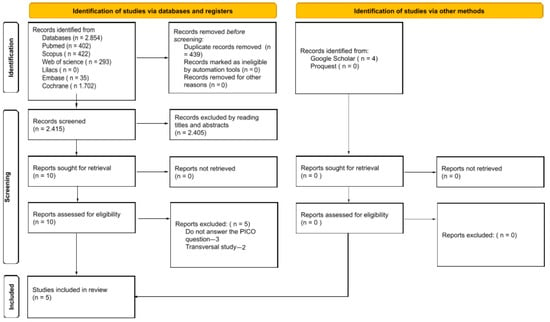
Figure 1
Open AccessArticle
Double Burden of Distress: Exploring the Joint Associations of Loneliness and Financial Strain with Suicidal Ideation During the COVID-19 Pandemic in Canada
by
Fahima Hassan, Lihui Liu and Cindy Feng
Int. J. Environ. Res. Public Health 2025, 22(5), 682; https://doi.org/10.3390/ijerph22050682 - 25 Apr 2025
Abstract
Background: The COVID-19 pandemic, coupled with social distancing measures and economic disruptions, has been associated with increased experiences of loneliness and financial strain. While prior research has examined their separate associations with suicidal ideation, limited attention has been given to their joint relationship.
[...] Read more.
Background: The COVID-19 pandemic, coupled with social distancing measures and economic disruptions, has been associated with increased experiences of loneliness and financial strain. While prior research has examined their separate associations with suicidal ideation, limited attention has been given to their joint relationship. Methods: We used data from the 2022 Mental Health and Access to Care Survey (MHACS) (n = 9861; ages 15+ in Canada) to assess whether financial strain modifies the association between loneliness or emotional distress and suicidal ideation. Multivariable survey-weighted logistic regression was conducted, adjusting for sociodemographic, economic, psychosocial, and health-related characteristics, including mental health and substance use conditions. Results: Among the 9743 respondents who answered the question on suicidal ideation, 355 (3.65%) reported suicidal ideation. Compared to individuals with neither stressor, those who experienced loneliness or emotional distress alone had 1.54 times higher odds of suicidal ideation (aOR = 1.54, 95% CI: 1.29–1.84, p < 0.001), while those who reported financial strain alone had 0.58 times the odds (aOR = 0.58, 95% CI: 0.43–0.80, p = 0.001). The highest odds were observed among individuals who experienced both loneliness/emotional distress and financial strain, with an adjusted odds ratio of 2.05 (95% CI: 1.71–2.45, p < 0.001), indicating an interaction between these stressors. Conclusion: The co-occurrence of loneliness or emotional distress and financial strain was associated with higher odds of suicidal ideation during the COVID-19 pandemic, compared to individuals experiencing neither stressor. These findings highlight the importance of considering both social and economic stressors when assessing mental health risks. Given the cross-sectional nature of this study, further longitudinal research is needed to explore the temporal relationships and potential causal pathways linking these experiences to suicidal ideation.
Full article
(This article belongs to the Special Issue Depression and Suicide: Current Perspectives)
Open AccessSystematic Review
Private Sector Engagement for Tuberculosis Services in Latin America: A Systematic Review
by
Carlos Podalirio Borges de Almeida, Leonid Lecca and Courtney M. Yuen
Int. J. Environ. Res. Public Health 2025, 22(5), 681; https://doi.org/10.3390/ijerph22050681 - 25 Apr 2025
Abstract
►▼
Show Figures
Objectives: Private sector engagement has been shown to improve tuberculosis diagnosis and treatment outcomes in Asia and Africa, but systematic reviews in 2015 and 2017 identified only two reports from Latin America. We conducted a systematic review to identify descriptions of private sector
[...] Read more.
Objectives: Private sector engagement has been shown to improve tuberculosis diagnosis and treatment outcomes in Asia and Africa, but systematic reviews in 2015 and 2017 identified only two reports from Latin America. We conducted a systematic review to identify descriptions of private sector engagement interventions for tuberculosis in Latin America. Methods: We systematically searched for reports on private sector engagement for tuberculosis services in Spanish- and Portuguese-speaking countries of the Western Hemisphere. On 1 November 2024, we searched PubMed, Embase, LILACS, and SciELO, with terms related to tuberculosis, the private sector, and eligible countries. We double-reviewed abstracts and full-text articles and classified private sector engagement mechanisms according to an established framework. Results: We identified seven documents describing five distinct interventions for private sector engagement in 10 countries. The most common engagement mechanism was technical support to increase awareness, knowledge, or capacity in the private sector. Intervention goals included promoting collaboration, ensuring adherence to national guidelines, increasing referrals to the public sector, and reducing tuberculosis drug sales in private pharmacies. Three impact evaluations found evidence of improved referral to the public sector. Conclusions: We found few reports of private sector engagement interventions for tuberculosis in Latin America, suggesting missed opportunities for collaborations to expand and improve tuberculosis service delivery. A lack of impact assessments suggests a dearth of evidence on the best models for private sector engagement to advance tuberculosis elimination in the Latin American region.
Full article
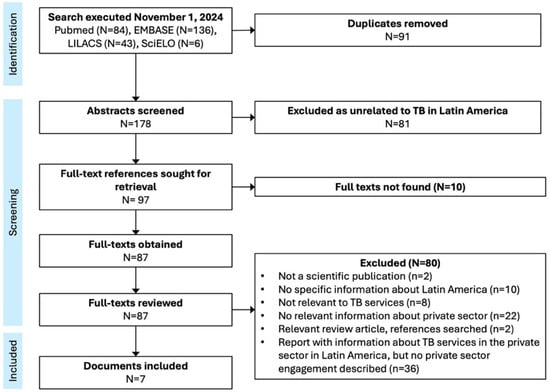
Figure 1
Open AccessArticle
Access to Vaccines in Floodplains and Hard-to-Reach Areas of the Brazilian Amazon: The Contribution of Street-Level Bureaucrats and the Use of Social Technologies
by
Jair Araújo de Lima, Anízia Aguiar Neta, Suze Mary Camurça Assis, Bruno de Oliveira Rodrigues and Helena Ribeiro
Int. J. Environ. Res. Public Health 2025, 22(5), 680; https://doi.org/10.3390/ijerph22050680 - 25 Apr 2025
Abstract
►▼
Show Figures
Introduction: Access to vaccines provided by the Brazilian National Immunization Program (NIP) to populations living in floodplains and hard-to-reach areas of the Amazon is complex and conditioned by the geographic characteristics of the region. The success of vaccination campaigns requires different strategies, technologies,
[...] Read more.
Introduction: Access to vaccines provided by the Brazilian National Immunization Program (NIP) to populations living in floodplains and hard-to-reach areas of the Amazon is complex and conditioned by the geographic characteristics of the region. The success of vaccination campaigns requires different strategies, technologies, and the involvement of professionals whose work goes beyond standard procedures and vaccination protocols. Objectives: To investigate the specificities of the immunization process of populations inhabiting floodplains and areas of difficult access in the municipality of Careiro da Várzea, in the state of Amazonas, Brazil. To analyze the theoretical and practical aspects of the National Immunization Program in the region. Methods: The case study included qualitative-descriptive techniques that combined data analysis, document analysis, and participant observation to reveal different socio-sanitary aspects of the immunization process of the Amazonian populations studied. The concepts of Street Level Bureaucracy and Social Technologies guided the analysis and description of the immunization process in the area studied. Results: The study described the geographic conditions, the social technologies used, and the individuals involved in the immunization process of the populations of communities and villages in flooded areas of the Amazon in Brazil. The high temperatures in the region create the need for thermal control in the storage of vaccines during their transfer to the communities and villages. The local coordination of the Imuniza SUS Program acts as a strategic mediator between the different bodies, ensuring the population’s access to vaccines, which means that the actions of government agents (Street Level Bureaucracy) are crucial to the functioning of the immunization program. Conclusions: The success of the immunization campaigns in the hard-to-reach flooded areas of the municipality is due to the existence of a virtuous cycle arising from the synergy between the different stakeholders that make up the immunization service; there is a clear relationship between the vaccination coverage rates achieved and the municipal administration’s commitment to public health. The immunization rates achieved in the municipality studied were compatible with the average established by the Brazilian Ministry of Health. This case study might enhance knowledge about health practices in this important world region.
Full article

Figure 1
Open AccessArticle
Impact of Different Occupational Noises on Static and Dynamic Postural Stability in Healthy Young Adults
by
Kristy Gourley, Harish Chander, Asher Street Beam and Adam C. Knight
Int. J. Environ. Res. Public Health 2025, 22(5), 679; https://doi.org/10.3390/ijerph22050679 - 25 Apr 2025
Abstract
Background: Sounds that cause disturbances and perturbations to the vestibular (inner ear organ responses) and visual (acute oculomotor responses) systems can impact postural stability. The purpose of this study was to assess the impact of different types of sounds and noises on both
[...] Read more.
Background: Sounds that cause disturbances and perturbations to the vestibular (inner ear organ responses) and visual (acute oculomotor responses) systems can impact postural stability. The purpose of this study was to assess the impact of different types of sounds and noises on both static and dynamic PS. Methods: A total of 20 participants (12 females and 8 males; age: 21.35 ± 1.79 years; height: 170.7 ± 9.3 cm; mass: 66.725 ± 14.1 kg) were tested using the limits of stability (LOS) test on the BTrackS™ balance plate and a Timed Up and Go (TUG) test, when exposed to four different sounds and occupational noises [construction noise (CN), white noise (WN), sirens (SRs), and nature sounds (NAs)] in a randomized order with a no sounds (NSs) control performed initially (intensity range of 70–80 dB). The center of pressure (COP) total sway area (cm2) from the LOS and the time to completion of the TUG (seconds) were analyzed using a one-way repeated measures of analysis of variance at an alpha level of 0.05. Results: The observations demonstrated significant differences between the sounds and noises for the TUG (p < 0.001) but not for the LOS test (p = 0.406). Pairwise comparisons for the significant main effect for the TUG revealed that NSs demonstrated significantly slower time to completion compared to CN, WN, and SRs but not NAs. Conclusions: The findings suggest that the different sounds and noises did not impact static PS during the LOS test, which involved the voluntary excursion of the COP while maintaining the same base of support (BOS). However, during dynamic PS with a changing BOS while walking in the TUG, exposure to CN, SRs, and WN demonstrated a faster completion time than NSs or NAs. This finding may be attributed to the anxiety induced by the noise immersion and perception of sounds, compared to calm NAs and no sounds. The findings can aid in better understanding the impact of different occupational noises on PS and emphasize the need for better noise protection and reduction in loud work environments.
Full article
(This article belongs to the Special Issue Work Environment Effects on Health and Safety of Employees)
►▼
Show Figures

Figure 1
Open AccessArticle
Lessons Learned in Transgender Peer Navigation: A Year of Reflective Journaling
by
Gwen Rose, Ken Mullock, Elijah Gatin, T. Fayant-McLeod, Michelle C. E. McCarron, Megan Clark and Stéphanie J. Madill
Int. J. Environ. Res. Public Health 2025, 22(5), 678; https://doi.org/10.3390/ijerph22050678 - 25 Apr 2025
Abstract
People who are trans and gender-diverse are underserved by the healthcare system; one way to improve healthcare access is with peer healthcare navigators. We piloted two trans peer health navigators from April 2021 to March 2022 in a small Canadian province. The purpose
[...] Read more.
People who are trans and gender-diverse are underserved by the healthcare system; one way to improve healthcare access is with peer healthcare navigators. We piloted two trans peer health navigators from April 2021 to March 2022 in a small Canadian province. The purpose of this study was to explore how trans peer navigators experienced their work and work environment through reflective journalling. The navigators journalled roughly weekly. They were encouraged to interrogate their own biases and to think about what was omitted from conversations with others. Each journal was treated as a qualitative case study, anonymized and analyzed thematically using Interpretive Phenomenological Analysis. Six themes emerged: expected work, unexpected work, teamwork, lived experience, challenges, and systemic factors. These themes were complexly interwoven with a network of subthemes that frequently fell under multiple main themes and were highly emotionally charged, many both positively and negatively. The importance of navigators being transgender themselves was highlighted. The rewards came from being able to provide meaningful help to people in their community and the challenges came from not being respected by other healthcare providers and systemic barriers that prevented them from helping clients. The navigators successfully adapted their services to bridge some systemic barriers. This research has implications for improving both navigators’ and clients’ experiences.
Full article
(This article belongs to the Special Issue Sexuality, Health, and Gender)
►▼
Show Figures

Figure 1
Open AccessArticle
Enhancing Nutrition Communication in Early Childhood Education Settings: Overcoming Challenges and Promoting Collaboration with Caregivers
by
Elder G. Varela, Ciana Bonfiglio, Jamie Zeldman, Alexandra Chavez and Amy R. Mobley
Int. J. Environ. Res. Public Health 2025, 22(5), 677; https://doi.org/10.3390/ijerph22050677 - 25 Apr 2025
Abstract
Early childhood plays a critical role in shaping food preferences and eating habits, emphasizing the importance of effective communication between families and Early Childhood Education (ECE) settings to promote healthy eating behaviors. This qualitative study examines ECE providers’ perspectives on barriers and facilitators
[...] Read more.
Early childhood plays a critical role in shaping food preferences and eating habits, emphasizing the importance of effective communication between families and Early Childhood Education (ECE) settings to promote healthy eating behaviors. This qualitative study examines ECE providers’ perspectives on barriers and facilitators to nutrition communication with caregivers, comparing Early Head Start/Head Start (EHS/HS) and non-EHS/HS centers. Semi-structured interviews were conducted via Zoom with ECE providers (n = 20) serving children aged 0–3 in Florida. Using inductive thematic analysis, two researchers independently coded the data, identified themes, and compared similarities and differences between EHS/HS and non-EHS/HS providers through an iterative review process. Participants were predominantly white (74%) females (95%) with an average of 7.6 years of work experience. Both EHS and non-EHS providers reported common barriers, including limited time, caregiver resistance to change, and language challenges. However, EHS providers identified additional issues like economic constraints, limited nutrition knowledge among both caregivers and providers, and restricted access to technology. In contrast, non-EHS providers emphasized trust issues and caregiver non-compliance with center policies. To improve communication, EHS providers suggested trust-building and documenting dietary intake for personalized interactions, while non-EHS providers recommended regular meetings and mobile messaging. Addressing these barriers is crucial for fostering collaboration between providers and caregivers and promoting healthy food habits in young children.
Full article
(This article belongs to the Special Issue Healthy Diet and Nutrition during Childhood and Adolescence)
Open AccessArticle
A Typology of Livable Communities and Older Adults’ Health in the U.S
by
Kyeongmo Kim, Denise Burnette, Sol Baik and Seon Kim
Int. J. Environ. Res. Public Health 2025, 22(5), 676; https://doi.org/10.3390/ijerph22050676 - 25 Apr 2025
Abstract
►▼
Show Figures
Neighborhoods with high-quality built environments and social environments are associated with older adults’ well-being. However, research on the complex interplay of neighborhood types and health outcomes is limited, as is the role of functional limitations. This study aims to: (1) identify neighborhood types,
[...] Read more.
Neighborhoods with high-quality built environments and social environments are associated with older adults’ well-being. However, research on the complex interplay of neighborhood types and health outcomes is limited, as is the role of functional limitations. This study aims to: (1) identify neighborhood types, (2) explore the association of neighborhood type and older adults’ health, and (3) assess whether functional status affects this association. We merged data from the 2017 AARP Age-Friendly Communities Surveys and the Livability Index. Our sample included 3211 adults aged 65 and older; the majority (59%) were female. Participants identified as non-Hispanic White (81%), Hispanic (8%), Black (6%), and a member of another racial/ethnic group (2%). Employing latent class analysis, we identified a four-class model of neighborhood types: “Connected yet Limited Services”, “Service Integrated”, “Healthy Environment Zones”, and “Supportive Social Engagement”. Older adults in “connected yet limited services” and “service-integrated” neighborhoods had worse self-rated health than those in “supportive social engagement” neighborhoods, especially among those who reported functional limitations. Our findings indicate that older adults with functional limitations particularly benefit from neighborhoods with robust health support and social engagement opportunities, highlighting the importance of designing inclusive and adaptable age-friendly environments to address diverse and changing needs.
Full article
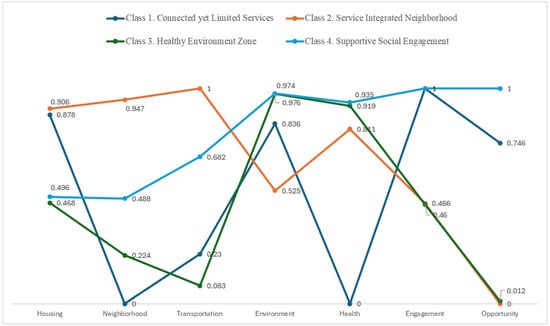
Figure 1
Open AccessReply
Reply to Kato et al. Comment on “Sokawa, Y. Radiation-Induced Childhood Thyroid Cancer after the Fukushima Daiichi Nuclear Power Plant Accident. Int. J. Environ. Res. Public Health 2024, 21, 1162”
by
Yoshihiro Sokawa
Int. J. Environ. Res. Public Health 2025, 22(5), 675; https://doi.org/10.3390/ijerph22050675 - 25 Apr 2025
Abstract
I thank you for considering my paper [...]
Full article
(This article belongs to the Section Environmental Health)
Open AccessComment
Comment on Sokawa, Y. Radiation-Induced Childhood Thyroid Cancer after the Fukushima Daiichi Nuclear Power Plant Accident. Int. J. Environ. Res. Public Health 2024, 21, 1162
by
Toshiko Kato, Mamoru Hayashi and Tadashi Hongyo
Int. J. Environ. Res. Public Health 2025, 22(5), 674; https://doi.org/10.3390/ijerph22050674 - 25 Apr 2025
Abstract
Sokawa studied the radiation effect on thyroid cancer after the Fukushima Daiichi Nuclear Power Plant Accident [...]
Full article
(This article belongs to the Section Environmental Health)
►▼
Show Figures

Figure 1
Open AccessArticle
Comorbidity Prevalence in Prediabetes and Type 2 Diabetes: A Cross-Sectional Study in a Predominantly Hispanic U.S.–Mexico Border Population
by
Ricardo X. Noriega, Juan J. Nañez, Emily F. Hartmann, John D. Beard, Chantel D. Sloan-Aagard and Evan L. Thacker
Int. J. Environ. Res. Public Health 2025, 22(5), 673; https://doi.org/10.3390/ijerph22050673 - 24 Apr 2025
Abstract
Type 2 diabetes and prediabetes are associated with a higher risk of several health conditions. We conducted a cross-sectional study to compare the prevalence of comorbidities among 88,724 adults with prediabetes and 12,071 adults with type 2 diabetes in El Paso, Texas, using
[...] Read more.
Type 2 diabetes and prediabetes are associated with a higher risk of several health conditions. We conducted a cross-sectional study to compare the prevalence of comorbidities among 88,724 adults with prediabetes and 12,071 adults with type 2 diabetes in El Paso, Texas, using data from the Paso del Norte Health Information Exchange (PHIX) from 1 January 2021, to 31 January 2023. We estimated prevalence ratios (aPR) adjusted for age decade, gender, and Hispanic ethnicity. Individuals with prediabetes, compared to type 2 diabetes, had lower adjusted prevalence of circulatory (59.1% vs. 80.4%; aPR = 0.82 [95% CI: 0.81–0.84]), genitourinary (44.9% vs. 50.5%; aPR = 0.97 [0.96–0.99]), respiratory (32.0% vs. 35.7%; aPR = 0.94 [0.92–0.97]), neurological (27.4% vs. 32.8%; aPR = 0.91 [0.88–0.94]), blood (21.2% vs. 30.5%; aPR = 0.77 [0.75–0.80]), mental (19.5% vs. 26.1%; aPR = 0.72 [0.69–0.75]), infectious (12.8% vs. 21.5%; aPR = 0.63 [0.60–0.66]), skin (12.2% vs. 14.8%; aPR = 0.82 [0.78–0.86]), and COVID-19 (10.2% vs. 11.9%; aPR = 0.86 [0.81–0.91]) diseases/conditions. Adjusted prevalence was higher among those with prediabetes for musculoskeletal (53.8% vs. 47.0%; aPR = 1.19 [1.17, 1.21]), ear (18.4% vs. 12.9%; aPR = 1.54 [1.47–1.60]), eye (11.1% vs. 7.8%; aPR = 1.52 [1.43, 1.61]), digestive (44.0% vs. 44.0%; aPR = 1.02 [1.00–1.05]), and neoplastic (14.4% vs. 14.5%; aPR = 1.12 [1.06–1.17]) diseases/conditions. People with prediabetes in El Paso, Texas, had a lower prevalence of most comorbidities than those with type 2 diabetes, suggesting that preventing prediabetes from progressing to type 2 diabetes could have a beneficial impact on comorbid disease burden.
Full article
(This article belongs to the Section Infectious Diseases, Chronic Diseases, and Disease Prevention)
►▼
Show Figures
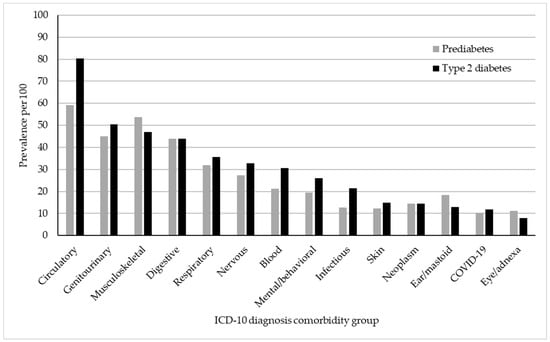
Figure 1
Open AccessArticle
Impact of Praziquantel Mass Drug Administration on Schistosomiasis: A Comparison of Prevalence and Risk Factors Between Treated School Aged Children and Untreated Adults in Abuja, Nigeria
by
Solomon M. Jacob, Sophie Y. Akinbo, Akinola S. Oluwole, Temitope Agbana, Zainab Omoruyi, Michael A. Okungbowa, Jan-Carel Diehl and Fredrick O. Akinbo
Int. J. Environ. Res. Public Health 2025, 22(5), 672; https://doi.org/10.3390/ijerph22050672 - 24 Apr 2025
Abstract
Introduction: One of the global strategies for the elimination of schistosomiasis is by Mass Drug Administration (MDA) of a single oral dose of praziquantel (40 mg/kg) without a prior individual diagnosis, with a target of >75% treatment coverage among school-aged children. This study
[...] Read more.
Introduction: One of the global strategies for the elimination of schistosomiasis is by Mass Drug Administration (MDA) of a single oral dose of praziquantel (40 mg/kg) without a prior individual diagnosis, with a target of >75% treatment coverage among school-aged children. This study was conducted to determine the endemicity of schistosomiasis among school-aged children and adults in Abuja, Nigeria. Methods: A total of 1370 participants were recruited, which consisted of 667 (48.67%) males and 703 (51.31%) females. Urine and stool specimens were collected from each participant and analyzed using standard procedures. Results: The overall prevalence of schistosomiasis was 27.5% in this study with Abuja Municipal having the highest prevalence of 49%, while the least (6.1%) was reported in Bwari LAC. The prevalence of schistosomiasis significantly differs (p < 0.05) between the area councils. The location of communities significantly affected the prevalence of schistosomiasis in Abaji, AMAC, and Gwagwalada LACs (p < 0.005). The Schistosoma recovered in this study were S. haematobium and S. mansoni. The prevalence of schistosomiasis increased from the baseline of 21.1% to 49% in Gwagwalada LAC. Gender significantly affected the prevalence of schistosomiasis as more males were infected (33.1%) than their female counterparts (22.2%) (p < 0.05). The prevalence of schistosomiasis was 31% and 23.9% among SAC and adults, respectively. The participants’ activities in the river significantly affected the prevalence of schistosomiasis in this study (p < 0.05). Conclusions: The clamour for urgent government and non-government intervention through alternate sources of water like boreholes or pipe-borne water, as well as implementing a behavioural change campaign across the communities to prevent the recurrence, are advocated.
Full article

Journal Menu
► ▼ Journal Menu-
- IJERPH Home
- Aims & Scope
- Editorial Board
- Reviewer Board
- Topical Advisory Panel
- Instructions for Authors
- Special Issues
- Topics
- Sections & Collections
- Article Processing Charge
- Indexing & Archiving
- Editor’s Choice Articles
- Most Cited & Viewed
- Journal Statistics
- Journal History
- Journal Awards
- Society Collaborations
- Conferences
- Editorial Office
Journal Browser
► ▼ Journal Browser-
arrow_forward_ios
Forthcoming issue
arrow_forward_ios Current issue - Vol. 22 (2025)
- Vol. 21 (2024)
- Vol. 20 (2023)
- Vol. 19 (2022)
- Vol. 18 (2021)
- Vol. 17 (2020)
- Vol. 16 (2019)
- Vol. 15 (2018)
- Vol. 14 (2017)
- Vol. 13 (2016)
- Vol. 12 (2015)
- Vol. 11 (2014)
- Vol. 10 (2013)
- Vol. 9 (2012)
- Vol. 8 (2011)
- Vol. 7 (2010)
- Vol. 6 (2009)
- Vol. 5 (2008)
- Vol. 4 (2007)
- Vol. 3 (2006)
- Vol. 2 (2005)
- Vol. 1 (2004)
Highly Accessed Articles
Latest Books
E-Mail Alert
News
26 April 2025
International Journal of Environmental Research and Public Health | An Interview with the Author—Dr. Nicole Redvers
International Journal of Environmental Research and Public Health | An Interview with the Author—Dr. Nicole Redvers

26 April 2025
International Journal of Environmental Research and Public Health | An Interview with the Author—Dr. Melba Sheila D’Souza
International Journal of Environmental Research and Public Health | An Interview with the Author—Dr. Melba Sheila D’Souza

Topics
Topic in
Environments, Forests, IJMS, Molecules, IJERPH
Molecules We Breathe: Volatile Phytocompounds for Forest Medicine
Topic Editors: Giovanni N. Roviello, Francesco MeneguzzoDeadline: 11 June 2025
Topic in
Healthcare, IJERPH, JCM, Nutrients, Sports
Effects of Exercise Behavior and Amount of Exercise on Public Health: How to Overcome Barriers to Increase Adherence
Topic Editors: Joao Gustavo Oliveira Claudino, Paula Alves Monteiro, Ana Carolina Paludo, Helder Fonseca, Enrico Fuini Puggina, Romulo Fernandes, Sílvia Rocha-Rodrigues, Julio Cerca SerraoDeadline: 1 July 2025
Topic in
Behavioral Sciences, Children, Healthcare, IJERPH, JFMK, Obesities
The Effect of Physical Activity on the Population's Health
Topic Editors: Stefania Paduano, Federica ValerianiDeadline: 31 July 2025
Topic in
Healthcare, IJERPH, JCM, Safety, Toxics
New Research in Work-Related Diseases, Safety and Health
Topic Editors: Alicja Bortkiewicz, Małgorzata KurpesaDeadline: 31 August 2025

Conferences
Special Issues
Special Issue in
IJERPH
The Lifelong Impact of Adverse Childhood Experiences on Health
Guest Editors: Ângela Rosa Pinho Costa Maia, Mariana GonçalvesDeadline: 30 April 2025
Special Issue in
IJERPH
Social Inequalities in Later Life: Care Services in the Future
Guest Editor: Ann LiljasDeadline: 30 April 2025
Special Issue in
IJERPH
Research on Emotional and Cognitive Development in Children
Guest Editor: Noemi FaeddaDeadline: 30 April 2025
Special Issue in
IJERPH
Understanding and Addressing Factors Related to Health Inequalities
Guest Editor: Nadav DavidovitchDeadline: 30 April 2025
Topical Collections
Topical Collection in
IJERPH
Health Behaviors, Risk Factors, NCDs and Health Promotion
Collection Editor: Stefano Campostrini
Topical Collection in
IJERPH
Outbreak of a Novel Coronavirus: A Global Health Threat
Collection Editor: Jianyong Wu





